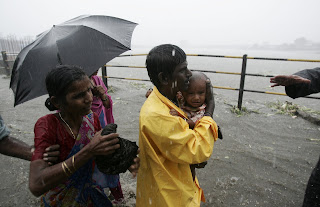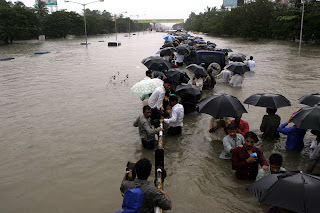Please check out the following story at the Hindustan Times website. When we wrote it, we thought we were addressing a limited audience. Continuing votes have proved us wrong; clearly a lot of Indians think the issue of urban drainage is worth worrying about.
http://www.hindustantimes.com/storypage/storypage.aspx?id=287aaca5-8ec4-417d-ab89-c7c043cc06dc&&Headline=A+drain+on+development
Monday, August 6, 2007
Delhi floods and Bluelines/ august 2007
When we were writing our page on urban floods, sitting in Delhi, the experts had told us that the capital does not have a fraction of Mumbai's capacity to deal with floods. And they seemed so correct last week when the monsoon came back to Delhi after a vacation. It only took a few hours of rains for every crossing from ITO to Dhaula Kuan to get innundated. God forbid that we get the kind of rains that Mumbai got back in 2005, when it poured nonstop for 24 hours.
In a capital which was already held at ransom by the withdrawal of Bluelines for inspections, the rains just added to the choas and confusion on the roads. With hardly 3 or 4 Bluelines running on each route, waiting for them at the open bus stops just added to the stormy nightmare. Getting into the buses also proved to be a test of one's patience with these buses crawling through the cities' water logged roads at a snail's pace. The ones who caught the buses were the lucky ones but even they had to get wet and dirty, when asked by the conducters to get down and give the buses a push.
In a capital which was already held at ransom by the withdrawal of Bluelines for inspections, the rains just added to the choas and confusion on the roads. With hardly 3 or 4 Bluelines running on each route, waiting for them at the open bus stops just added to the stormy nightmare. Getting into the buses also proved to be a test of one's patience with these buses crawling through the cities' water logged roads at a snail's pace. The ones who caught the buses were the lucky ones but even they had to get wet and dirty, when asked by the conducters to get down and give the buses a push.
Friday, July 27, 2007
Mumbai floods 2005 III
Delhi floods 2003

Early morning Indian commuters travel through a flooded street after a night of heavy monsoon rains in New Delhi July 11, 2003. The progress of the monsoon in India, where more than two-thirds of the billion strong population lives off agriculture, is keenly watched by farmers, economists, bond traders and stock brokers. REUTERS/B. Mathur
Mumbai floods 2005 II
Thursday, July 26, 2007
Mumbai floods 2005
Wednesday, July 25, 2007
Ban plastic bags
After reading our special page, S Bhatt, a reader, wrote to us that we should do stories on how plastic bags are clogging our drains and use of plastic bags should be immediately banned. This, he says will reduce the problem and our our cities will become clean.
In fact, Himachal Pradesh was the first state in the country to ban use of plastic bags. Delhi too started the process few years before, but nobody follows and allmost all grocerrs, vegetable sellers and even high end department stores still gives plastic bags.
In fact, Himachal Pradesh was the first state in the country to ban use of plastic bags. Delhi too started the process few years before, but nobody follows and allmost all grocerrs, vegetable sellers and even high end department stores still gives plastic bags.
Mumbai needs more fund
Will drains in Mumbai get a facelift now? The prime minister has sanctioned Rs 1200 crore to the city authorities to upgrade its 70 years old drainage system and build new drainage infrastructure. But after speaking to experts it seems that the amount is just not sufficient and would ideally need around Rs 2500 crore to be spent in the next ten years for upgradation of drains.
The project, called BRIMSTOWARD, was first conceptualised in 1990 by the World Bank. But the state government found Rs 1200 crore to much for drains and shelved the project. But after 2005 Mumbai floods, they stood up and decided to implement the project. The amount, keeping appreciation in mind should have been around Rs 2000 crore. Experts say it's a good start and other cities shoould also draw up similar models and take special grants from the Centre.
The project, called BRIMSTOWARD, was first conceptualised in 1990 by the World Bank. But the state government found Rs 1200 crore to much for drains and shelved the project. But after 2005 Mumbai floods, they stood up and decided to implement the project. The amount, keeping appreciation in mind should have been around Rs 2000 crore. Experts say it's a good start and other cities shoould also draw up similar models and take special grants from the Centre.
Friday, July 20, 2007
it's not rocket science II
One of our readers, RP Singh of Janakpuri, wrote back to us: The only question that always bothers me , why do we use drinking water in our toilets? Can't we use sea water instead? When we can carry human waste to the sea, why can't we bring sea water to our toilets? Why does our govt spend crores of rupees on cleaning up water for us to drink, which we just flush away....We drink one glass but waste 20 litres every time we answer nature's call.....
Thursday, July 19, 2007
it's not rocket science
When we began researching urban drainage, the very first expert we met warned us that if Delhi were to get the kind of rains that Bombay got back in that terrible July of 2005, it would go under water for at least a month. A few hours after this exchange, it started pouring. The autowallah who took me back home that night, eerily echoed the expert I had met earlier in the day. His previous fare had missed making it to the New Delhi railway station because just an hour of heavy rainfall had overwhelmed the ITO crossing, and the unfortunate vehicles that happened to be caught at the wrong place, wrong time. So what would Delhi do if the monsoon gods gave it their good graces for 24 or even 12 hours?
Rain rain go away, come again when we are better prepared
In Delhi, a city usually parched, rains are always welcome. Don’t we just love to lift our faces to the skies to better enjoy the cool and soothing effect of the city’s first rains? And then in precisely 24 hrs the romance dies as we walks with our heads down, cursing and muttering, zig zagging across the city’s water logged streets, jumping from one brick to another to avoid that suspicious piece of foul smelling crap that’s insistently dodging us.
Well its high time (and I mean literally, not just metaphorically) that we take our drains seriously and try getting inspired by what other countries are doing. And they are doing a lot….
If Tokyo is using infiltration pits and trenches, then France is using filter drains, Zurich is using silt traps, Scotland and Australia are using detention ponds and US and Sweden are using bioswales, buffer strips and porous pavements to solve their drainage problems.
Another good example is the city of Zurich. Under its ‘stream daylighting’ or revitalizing program more than 16'000 m of the city’s streams were brought back to life and some 250 liters of extraneous water diverted to them, reducing the burden on the city’s sewage treatment plant. For more see http://www.gsd.harvard.edu/events/conferences/restoration/pages/program/abstracts/zurichstream.htm.
In India one interesting but relatively unheard of technology being used is the 'eco-phalt' road technology that uses a special ingredient, called Drain Asphalt Modified Additive or DAMA that helps the road remain dry even in rains by sucking in the surface water. To find out more read http://www.skalmadi.org/story/2004/8/2/42430/54884.
For more on other innovative fixes to fix our drainage problems read my article at http://hindustantimes.com/StoryPage/StoryPage.aspx?id=77c427ab-3554-407d-97e2-7d69a35b7d50
Or share with me other techniques and technologies that are being used to clean our drains at cooshalle.samuel@hindustantimes.com
Well its high time (and I mean literally, not just metaphorically) that we take our drains seriously and try getting inspired by what other countries are doing. And they are doing a lot….
If Tokyo is using infiltration pits and trenches, then France is using filter drains, Zurich is using silt traps, Scotland and Australia are using detention ponds and US and Sweden are using bioswales, buffer strips and porous pavements to solve their drainage problems.
Another good example is the city of Zurich. Under its ‘stream daylighting’ or revitalizing program more than 16'000 m of the city’s streams were brought back to life and some 250 liters of extraneous water diverted to them, reducing the burden on the city’s sewage treatment plant. For more see http://www.gsd.harvard.edu/events/conferences/restoration/pages/program/abstracts/zurichstream.htm.
In India one interesting but relatively unheard of technology being used is the 'eco-phalt' road technology that uses a special ingredient, called Drain Asphalt Modified Additive or DAMA that helps the road remain dry even in rains by sucking in the surface water. To find out more read http://www.skalmadi.org/story/2004/8/2/42430/54884.
For more on other innovative fixes to fix our drainage problems read my article at http://hindustantimes.com/StoryPage/StoryPage.aspx?id=77c427ab-3554-407d-97e2-7d69a35b7d50
Or share with me other techniques and technologies that are being used to clean our drains at cooshalle.samuel@hindustantimes.com
The urban millenium
You are never gonna believe this, but its true. India is getting urbanised at a faster rate than the rest of the world. While today India’s urban areas hold less than 30 per cent of its population, by 2030 they will contain 40.7 per cent, i.e some 590 million urbanities. Check out the UNFP website http://www.unfpa.org/swp/2007/english/introduction.htm that talks about the “Dawn of an Urban Millennium.”
And while we might be all ready to embrace and celebrate our “urbaness”, our cities are reeling under the inevitable pressures generated by this urbanisation process. Destruction of natural streams, lakes and vegetation, haphazard city planning, freak weather patterns and most importantly improper maintenance of drains have all increased the frequency of flash floods in our cramped.
In 2005, 10 major cities in India suffered recurring and prolonged floods. And in 2006 this number increased to over 20 cities. For more on the flood situation in south Asia and India check out this report by http://www.southasiandisasters.net at this address http://www.southasiadisasters.net/downloads/snet/snet-17.pdf.
or mail me at cooshalle.samuel@hindustntimes.com.
And while we might be all ready to embrace and celebrate our “urbaness”, our cities are reeling under the inevitable pressures generated by this urbanisation process. Destruction of natural streams, lakes and vegetation, haphazard city planning, freak weather patterns and most importantly improper maintenance of drains have all increased the frequency of flash floods in our cramped.
In 2005, 10 major cities in India suffered recurring and prolonged floods. And in 2006 this number increased to over 20 cities. For more on the flood situation in south Asia and India check out this report by http://www.southasiandisasters.net at this address http://www.southasiadisasters.net/downloads/snet/snet-17.pdf.
or mail me at cooshalle.samuel@hindustntimes.com.
HT India Urban Flooding issues
Doing a special package on urban floods/ city drainage, I thought not many people would be interested in a topic like that. But I was wrong. I realised that even my mother had views on it. Once HT special package was out, we started getting interesting feedback, stories, pictures and even poetry from readers.
So as far as I am concerned, urban drainage is one of the most evocative issues for urbanites.
Vipul
So as far as I am concerned, urban drainage is one of the most evocative issues for urbanites.
Vipul
Subscribe to:
Posts (Atom)


